On this review, we are taking a good look at Plextor’s M9PE NVME SSD. What we’ve got is the 512GB model in an M.2 form factor, featuring 3D NAND flash memory inside. This is a PCI-E SSD, featuring a 5-year Limited Warranty.
The Plextor’s M9PE has 3 main models to choose from, with 256GB, 512GB and 1TB models at bay. Our 512GB variant has transfer speeds rated up to 3200MB/s read and 2000MB/s write. Learn more from the official product page and get it at Amazon.
TECHNICAL SPECIFICATIONS:
|
Specifications |
|||||
| Model | PX-256M9PeGN | PX-512M9PeGN | PX-1TM9PeGN | ||
| Capacity | 256 GB | 512 GB | 1 TB | ||
| Cache | 512 MB LPDDR3 | 512 MB LPDDR3 | 1024 MB LPDDR3 | ||
| Controller | Marvell 88SS1093 | ||||
| NAND Flash | TOSHIBA BiCS3 3D TLC | ||||
|
Performance (Under Windows NTFS) |
|||||
| Sequential Read Speed (MB/s) | Up to 3,000 | Up to 3,200 | Up to 3,200 | ||
| Sequential Write Speed (MB/s) | Up to 1,000 | Up to 2,000 | Up to 2,100 | ||
| Random Read Speed (IOPS) | Up to 180,000 | Up to 340,000 | Up to 400,000 | ||
| Random Write Speed (IOPS) | Up to 160,000 | Up to 280,000 | Up to 300,000 | ||
|
Environment and Reliability |
|||||
| Power Requirement | DC 3.3V 2.5A (Max.) | ||||
| Temperature | 0℃ ~70℃ / 32℉ ~ 158℉ (Operating) | ||||
| MTBF | >1,500,000 Hours | ||||
| Endurance (TBW) | 160 | 320 | 640 | ||
| Warranty | 5 years | ||||
|
Compatibility |
|||||
| Operating System | Microsoft Windows 8.1, 10/ Linux OS | ||||
| Supported | UL, TUV, FCC, CE, BSMI, VCCI, RCM, KCC, EAC, ROHS, WHQL | ||||
| Agency Approval | TRIM, S.M.A.R.T, IO queue, NVMe command | ||||
| Command Set Support | M.2 PCIe Gen 3 x 4 with NVM Express | ||||
| Interface | Supported | ||||
|
Form Factor and Connectors |
|||||
| Form Factor | M.2 2280 | ||||
| Power Connector | M.2 connector for DC 3.3V input | ||||
| Data Connector | M.2 Connector | ||||
|
Dimension and Weight |
|||||
| Dimension (L x W x H) | 80.00 x 22.00 x 2.30 mm | 80.00 x 22.00 x 3.65mm | |||
| Weight (Max.) | 10g / 0.35oz | ||||
|
Package Content |
|||||
| Drive | 256GB / 512GB / 1TB SSD | ||||
Plextor provided all the necessary information to get us started with the drive. That being said, the M9PE is no slouch when it comes to specifications.
PACKAGING AND ACCESSORIES:
The PCI-E SSD is packed inside the usual Plextor packaging. It’s slim and looks flimsy. Surprisingly, it protected the drive pretty well against elements.
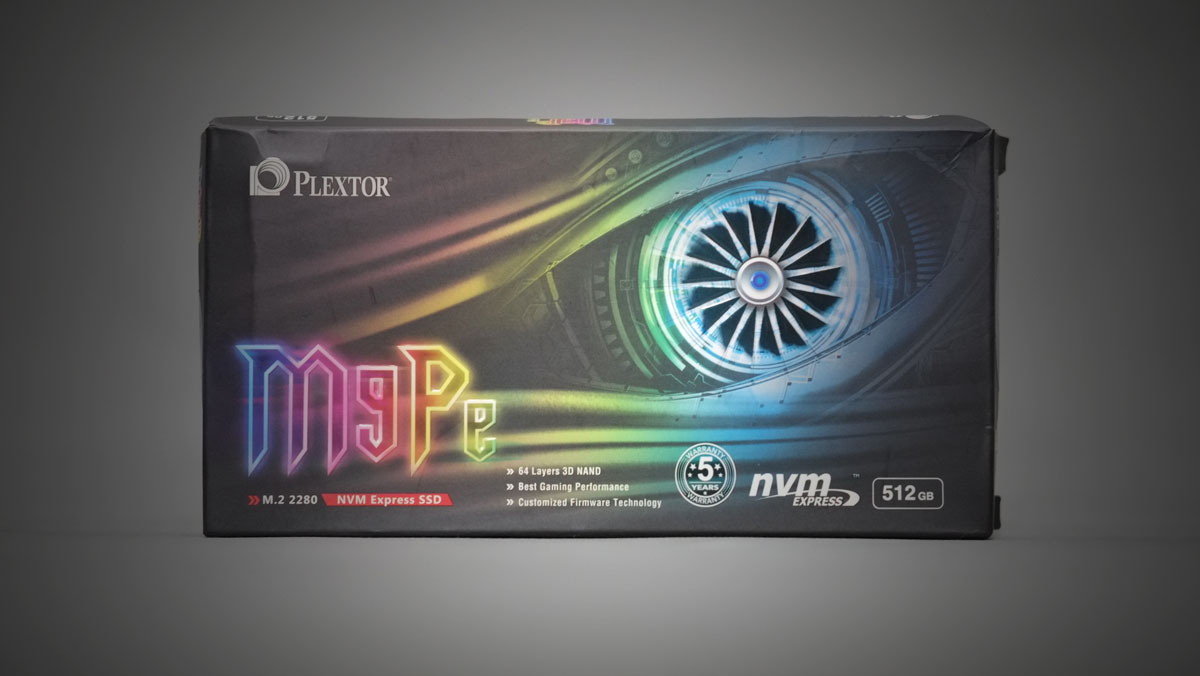
Inside, you’ll find a screw for the mounting. No other stuff to be found with of course, the exception of the drive.
DESIGN, LAYOUT AND CONNECTIVITY:
The Plextror M9PE NVME PCI-E SSD is not much different aesthetic-wise from previous M.2 SSDs we’ve tested. No heatsink here to protect the drive from throttling, nor fancy gaming inspired aesthetics. The Marvell 88SS1093 controller could be seen here, while TOSHIBA’s BiCS3 3D NAND flashes are mostly kept hidden by a large sticker.
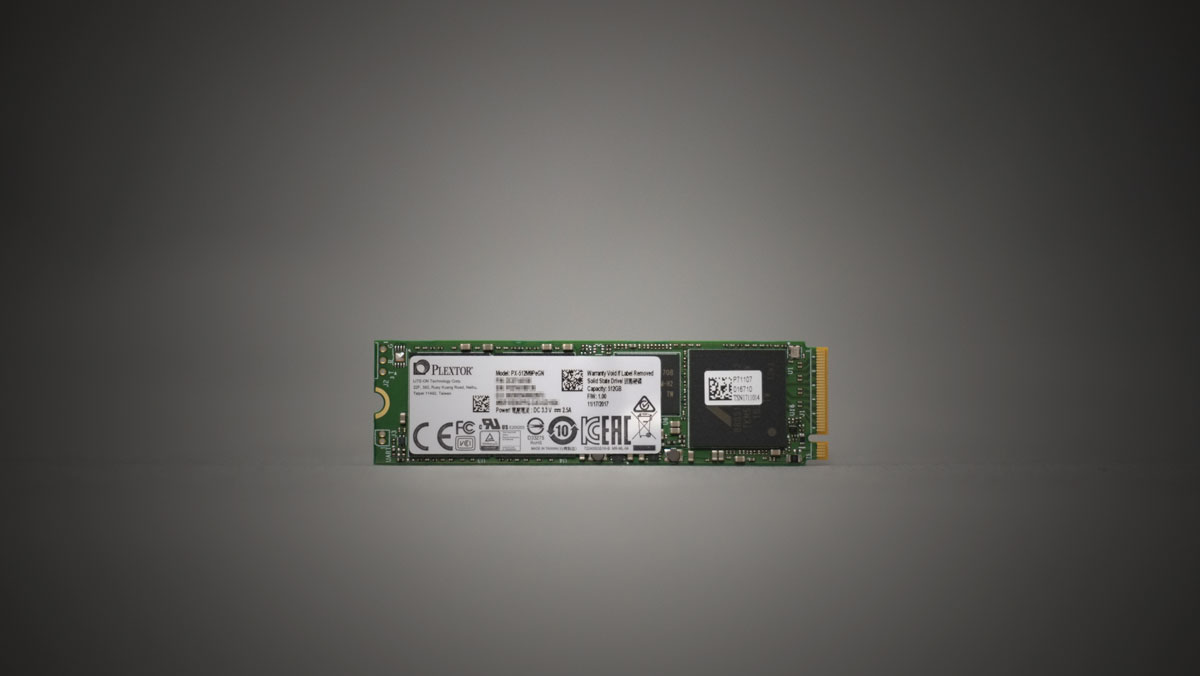
What I like about this setup though is the single sided design. This allows for better temperature management with motherboards that features M.2 cooling solutions.
TEST SETUP AND METHODOLOGY:
Our storage device reviews revolves around the use of various storage benchmark tools and real world benchmarks. Our setup fills up the test drive to at least 50% of its capacity. This is done so to negate the FOB (Fresh Out the Box) performance of the drive; ensuring that we are testing the drive near its expected usage. The drive is formatted under NTFS and is attached to its natively supported interface. This is to ensure the system is at its optimal testing state.
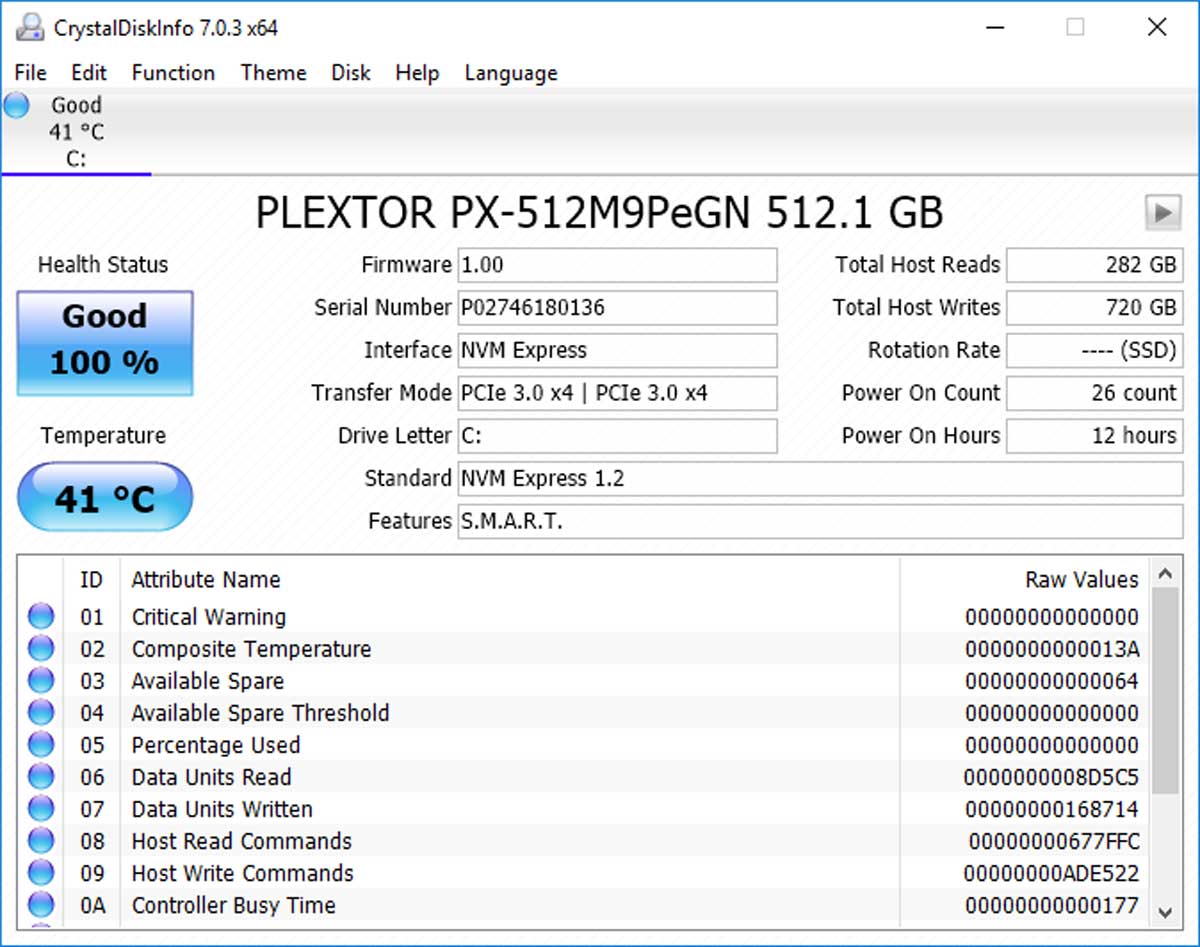
| TEST SYSTEM SPECIFICATIONS | |
| PROCESSOR | Intel Core i5-6600K |
| MOTHERBOARD | ASUS Z170-A |
| CPU COOLER | Cryorig C1 Top Flow |
| MEMORY KIT | Crucial Ballistix Tactical @ 2666MHz 4x4GB Kit |
| GRAPHICS CARD | ASUS GTX 1060 STRIX OC 6GB |
| INTERNAL STORAGE | Crucial BX200 480GB |
| POWER SUPPLY | CORSAIR RM850X 850W |
| DISPLAY | 27″ DELL U2715H + LG 43UF680T 4K UHD TV |
| OPERATING SYSTEM | Microsoft Windows 10 Pro |
THROUGHPUT PERFORMANCE:
Throughput performance measured in MB/s is measured with CrystalDiskMark. First up on the test is the Sequential read and write performance, measured with a block size of 1MB, 1GB transfer size and 32 Queue Depth. This test is more in line with large file transfers; similar to watching a movie.

The second one is the Random 4K read and write performance, measured with a random block size of 4KB, 1GB transfer size and 32 Queue Depth. This test is more in line with small file transfers; similar to transferring installation files and reading game data.
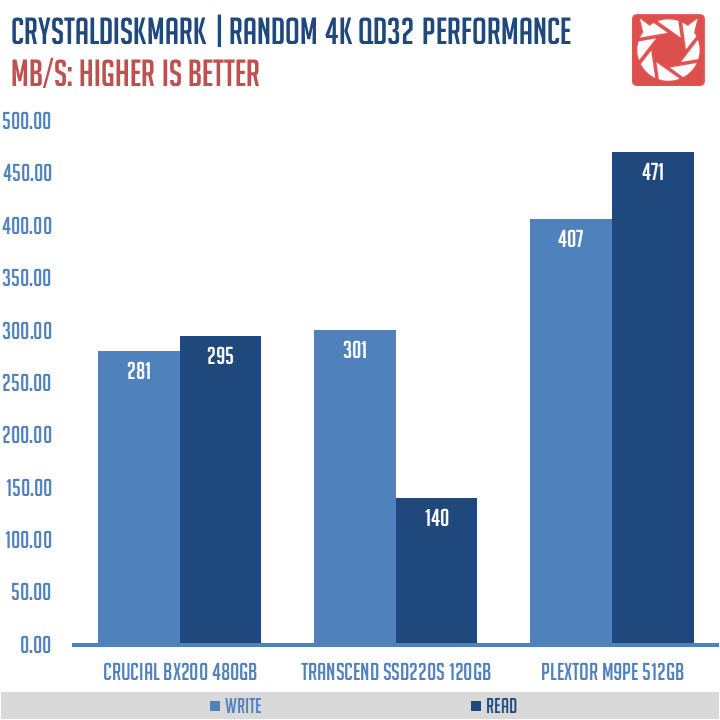
Sequential transfers rate is excellent for both read and write – able to achieve 3195 MB/s for the read and 2014 MB/s for the write. Random 4K performance is also good at 407 MB/s for the write and 471 MB/s for the read respectively.
IOPS PERFORMANCE:
Input/Output Operations per Second is is measured with AS SSD. The Random 4K-64Thrd read and write benchmark is used for this test. Performance is measured with a random block size of 4KB, a 1GB transfer size and 64-thread IO requests. This tests the storage medium’s ability to use Native Command Queuing (NCQ) at higher Queue Depth. A Useful metric for server side applications.
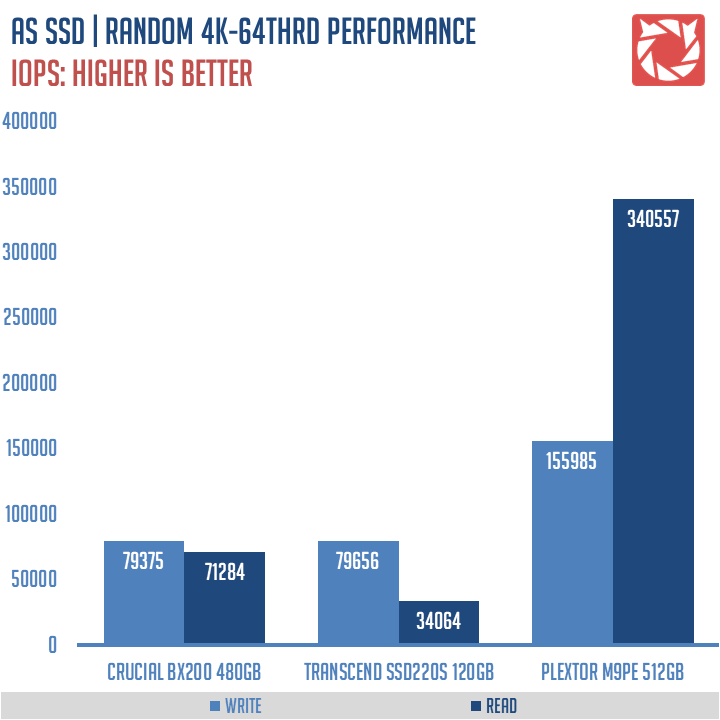
IOPS performance is generally good at 155K IOPS for the write, while read performance hovers around the 340K IOPS mark. Excellent read IOPS performance, while the write IOPS is just decent.
ACCESS TIME PERFORMANCE:
The read and write latency is measured with AS SSD using a 512KB block size. Access Time is just as important as the throughput and IOPS performance of the drive; allowing us to peak into how fast or slow a storage medium can access a given data. Latency is measured in milliseconds.
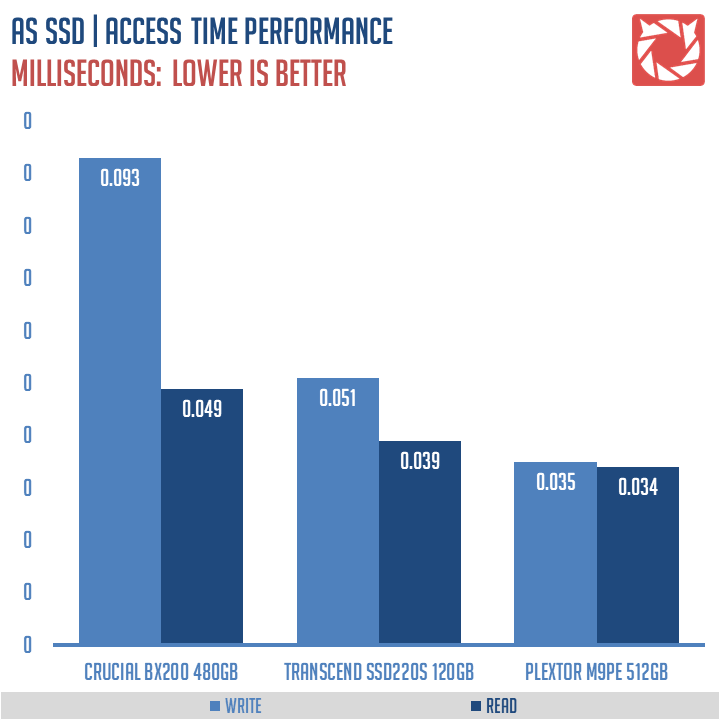
Read latency is recorded at 0.034ms, while the write latency is at 0.035ms. Excellent results for both read and write.
REAL WORLD PERFORMANCE:
Our real world performance test consists of 3 file folders containing 6GB worth of text files, images and videos each. The files are copied within the drive using TeraCopy to evaluate the storage medium’s performance. File copy performance is measured in seconds.
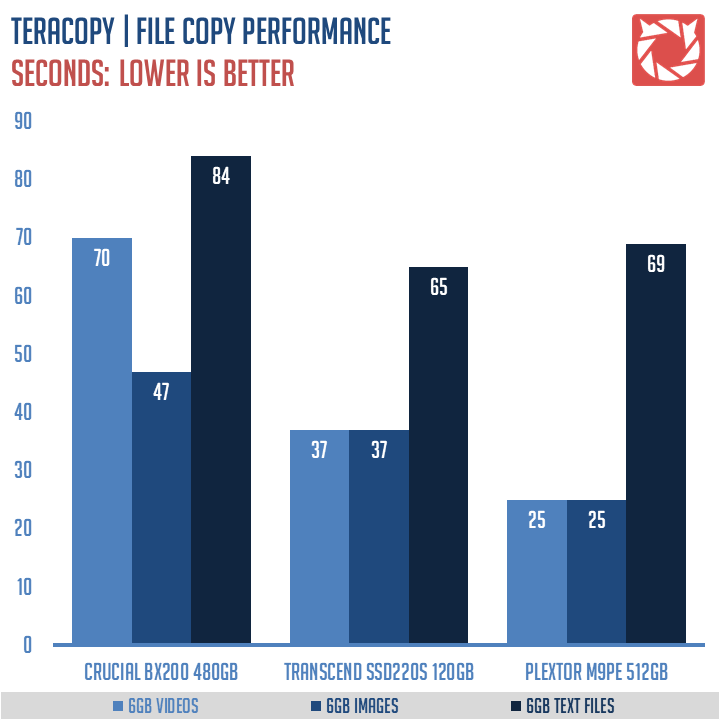
The Plextor M9PE NVME SSD is just fast when it comes to our file copy performance suite. Transcend’s 2.5″ SSD surprisingly got a faster figure on the text files. Plextor’s M9PE demolishes everything though on both the larger file copy tests.
WRAPPING IT UP:
The Plextor M9PE NVME 512GB PCI-E M.2 SSD is a fast SSD with a $232 MSRP. It is intended to function as a high capacity, high performance SSD and it did not missed the mark. Performance wise, we are looking at a proper NVME solution here. It has an excellent real world performance figures, while synthetics are just exceptional. Top notch so to speak, but it aint perfect.
While we like how fast it is on general, the SSD’s Random 4K write performance could use a nudge. It is rated at 280K IOPS but we only got around 150K IOPS on the benchmarks. At maximum load via AS SSD, the M9PE got a temperature of 59ºC. That said, the unit doesn’t look like it’s throttling down during our tests. Hot, but not scorching hot.
The Plextor M9PE NVME 512GB PCI-E M.2 SSD is actually a value oriented NVME SSD if you look carefully at its price and performance. An excellent alternative to the usual champs of the segment’s price.
|
|
Plextor M9PE NVME 512GB PCI-E M.2 SSD
-
PERFORMANCE - 9/10
9/10
-
BUILD QUALITY - 7/10
7/10
-
FEATURES - 8/10
8/10
-
AESTHETICS - 7/10
7/10
-
VALUE - 9/10
9/10
Summary
The Plextor M9PE NVME 512GB PCI-E M.2 SSD is a fast SSD with a $232 MSRP. It is intended to function as a high capacity, high performance SSD and it did not missed the mark.

With havin so much content do you ever run into any issues of plagorism or copyright infringement?
My site has a lot of exclusive content I’ve either written myself or outsourced but it seems a lot
of it is popping it up all over the web without my authorization. Do
you know any methods to help stop content from being ripped
off? I’d genuinely appreciate it.